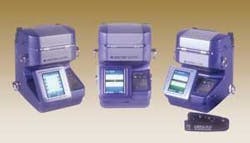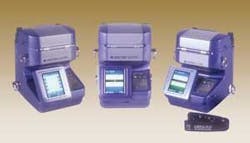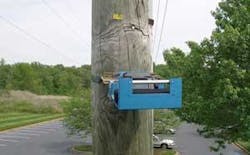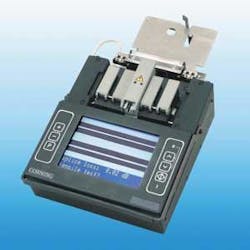For this growing application, the right equipment boasts portability, durability, and precision.
he burgeoning fiber-to-the-premises marketplace is, by all accounts, a fast-moving field. According to analysis from Render Vanderslice & Associates (www.rvallc.com), the number of so-called “fiber-optic communities” in the United States nearly doubled in the six months from October 2004 to April 2005, with the number of homes passed by fiber increasing 60% in the same period, to 1.6 million. Clearly, this widespread deployment of optical fiber represents a boom to the optical-fiber industry that busted so badly with the telecom market’s collapse earlier in the decade.
One of the residual effects of such rapid market growth is the need for tools of all types, including fusion splicers that play a part in terminating fiber strands at the customer premises. While fusion splicers have been readily available and have bonded fibers in long-haul fiber networks for some time, the labor and environments that characterize fiber-to-the-premises establish different criteria for these splicers.
A long way from long-haul
“In long-haul environments, technicians are conducting numerous splices and need mass-fusion splicers,” explains Josh Seawell, a product manager for Sumitomo Electric Lightwave’s splicing equipment. That differs from fiber-to-the-prem applications, he says, in which many of the splices are single-fiber connections.
Francois Barbeau, product line manager for test and splice with Corning Cable Systems, adds, “In fiber-to-the-premises deployments with a passive optical network [PON] architecture, the distances are relatively short, and the fiber counts to be spliced at a single location are moderate to very low.” There are three basic locations where fusion splicing may be required, he says: at the local convergence point (LCP) cabinet where the first or only optical splitter is located; at the network access point (NAP) terminal, where the interconnection to the drop cable is made; and at the residence with the optical network terminal (ONT).
“Long-haul splicing is most often performed in a splicing van or trailer,” says Mark Boxer, fusion-splicing systems engineering manager with AFL Telecommunications. “Fiber-to-the-premises splicing occurs in a very diverse set of environments. Splicing can occur inside a building, outside near a hand hole or maintenance hole, on the side of a house, on a pole, or in a bucket truck.”
The number of splices being performed in these deployments, and the environments in which they are performed, mandate that a splicer exhibit certain characteristics. “Portability and durability are key,” says Sumitomo’s Seawell. “Technicians need to set the splicer up quickly, use it, and break it down quickly.”
Easy does it
That is just the beginning. “Ease-of-use and the speed of training are factors as well,” Seawell continues. “You can’t send a single crew to splice 844 fibers with a mass fusion splicer. The number of people that a company like Verizon uses to conduct these splices varies month-to-month and day-to-day. Some of the technicians are converted copper splicers new to fiber-optic splicing.”
Alcoa Fujikura’s Boxer concurs, commenting that fiber-to-the-premises splicing “is often performed by relatively inexperienced technicians. This means that a splicer platform needs to be easy and intuitive to use, but also have appropriate safeguards and messages to ensure that potential errors are identified and corrected before the technician leaves the scene.”
He adds, “Splicing deep into the network often occurs in smaller quantities. This means that battery life is not quite as critical for the fiber-to-the-premises application, so battery capacity can be reduced to cut down on overall splicer size.”
But you won’t find any splicer manufacturer willing to compromise on splice quality, particularly in the area of average loss per splice. “Even in fiber-to-the-premises, splice losses should not be allowed over 0.1 or 0.2 dB max, for at least three reasons,” says Larry Wesson, president of Aurora Instruments. “First, future systems-not to mention present-day ones-will not allow any excess loss. Video, telecom, and data transmission will continue to advance in sophistication and speed, and accepting third-rate installation now means building networks that are obsolete from the beginning. Second, lossy splices are commonly associated with physical defects, which will lead to breakage sometime after completion, whether days, weeks, or years. Third, lossy splices also are commonly associated with backreflection, which can cause fatal instability in broadband systems.”
These points are significant because, as Sumitomo Electric’s Seawell points out, fiber-to-the-premises is “more or less a race among carriers, cable operators, and municipalities. Whoever is first with triple-play to the user wins.” Click here to view Fusion Splicers Product Update
So, a fusion splicer that will be used in fiber-to-the-premises applications essentially must have the same qualities as splicers used in long-haul systems-low loss, quick splice times, ease of use-and also must be portable (small, lightweight) as well as easy-to-use. From that perspective, fiber-to-the-premises splicers are not “scaled down.” How, then, do these manufacturers build these qualities into their fiber-to-the-prem splicing products? Each vendor takes its own approach and applies its own philosophy.
Made to fit
Alcoa Fujikura and Sumitomo Electric Lightwave each have a family of splicers for this application, and Aurora Instruments and Corning Cable Systems each offer a single splicer particularly for fiber-to-the-prem.
Alcoa Fujikura’s four fiber-to-the-prem splicers include the FSM-17S, FSM-17R, and two versions of the SpliceMate. The FSM-17S and one SpliceMate model are meant for single-fiber applications, while the FSM-17R and the other SpliceMate model handle up to 4-fiber ribbon applications.
“All of these splicers use fixed V-groove technology rather than core-alignment technology,” Boxer states. “Fixed V-groove are a good choice for fiber-to-the-prem applications, where many splicers are purchased.” The FSM-17S series has a similar footprint to AFL’s other field splicers, but is priced lower. The SpliceMate series “basically redefines how we and our customers think about splicing,” Boxer continues. “When most people first see it, they often don’t think it’s a splicer because it’s so small, and the workstation allows all of the materials to be stored in a small, portable package.”
Sumitomo Electric Lightwave offers the TomCat series, including the Type-25U, Type-25S, and Type-25M. All three use fixed V-groove alignment technology and share other characteristics as well, including an under-13-second average splice time, and the ability to conduct 30 splices on a fully charged battery. The products differ in that the 25U and 25S are single-fiber splicers, while the 25M splices up to a 4-fiber ribbon. The 25U also has a higher typical splice loss than the 25S and 25M. The 25U does not include splice-loss estimation, while the 25S and 25M do.
The series provides the characteristics that customers are looking for, Seawell says: “Its ergonomic design is small, but not too small for somebody with large hands and fingers. It provides the portability and low cost that our customers have told us they need, and all the splicers in the TomCat family are user-friendly and easy to learn.”
Corning Cable Systems’ FTTx75 fusion splicer “features an evolutionary design based on the fixed V-groove X75 splicer platform and was developed to address the unique requirements of fiber-to-the-premises networks,” says Barbeau. “The design was focused on the reduced size and weight, extended battery life, and costs required for a fiber-to-the-premises deployment, while employing the same reliable splicing technology used on our other fusion splicers. The result is a splicer that is approximately 50% smaller than the X75, weighs 35% less, and can do up to 100 splices on a single battery charge, without heat shrinks, using nickel-metal-hydride batteries.”
Three-axes core alignment
Aurora did not switch to V-groove technology for its Altima X fiber-to-the-premises fusion splicer. Wesson says the Altima X “is unique in providing, within a small package, true 3-axes core alignment using both PAS [profile alignment system] and LID [local injection and detection] methods. The Altima X provides the very-low splice losses and high yields typical of benchtop automatic fusion splicers, but in a go-anywhere, hand-holdable package.”
The Aurora splicer’s other features include nanometer-scale fiber positioning, modularity, and the ability to splice properly in level, vertical, sideways, and inverted orientations.
Sumitomo Electric Lightwave and Alcoa Fujikura Ltd. also offer a selection of accessories to complement the splicer. “Our customers have told us that splicing accessories are a very important piece of the puzzle, which is why we developed the workstations for the various splicers,” says AFL’s Boxer. The workstations capture the splicer and accessories to avoid drops when the equipment is used in an aerial configuration, he adds. They also include small, lightweight hardware that allows mounting to a closure, pole, bucket truck, NID, tripod, or other field equipment.
Sumitomo’s accessories include the FC-7 cleaver-a handheld device that makes cleaving a one-step process. A technician can strap the cleaver to his or her wrist, cleave the fiber in one step, let go of the cleaver, and continue with the application without disruption. Sumitomo’s Seawell points out that installation costs make up 40 to 50% of overall system cost, and measures taken to increase installation efficiency will pay off.
In the mid- to late-1990s, the communications market was exemplified by the phenomenal growth of Internet access. Yet for all the flash associated with surfing the Web, behind the scenes it was necessary for someone to install cables and competently terminate them to 8-pin modular jacks at each desktop. Today, the allure of fiber-to-the-premises and its promise of triple-play services have whetted the appetites of residential and business consumers.
The need for reliable connectivity of that media is arguably more crucial now than it was a decade ago. Modern fusion-splicing technology aims to make that crucial need a non-issue.
PATRICK McLAUGHLIN is chief editor of Cabling Installation & Maintenance.



